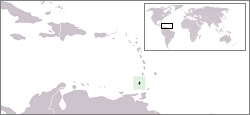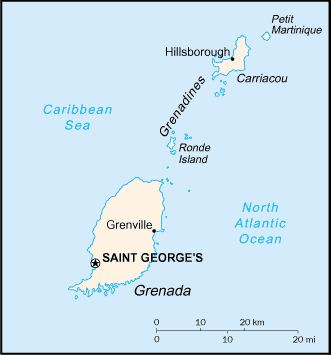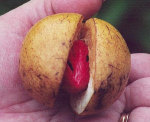Grenada
2007 Schools Wikipedia Selection. Related subjects: Central & South American Countries; Countries
| Grenada | |||||
|
|||||
| Motto: Ever Conscious of God We Aspire, Build and Advance as One People | |||||
| Anthem: Hail Grenada Royal anthem: God Save the Queen |
|||||
| Capital (and largest city) |
St. George's |
||||
| Official languages | English | ||||
|---|---|---|---|---|---|
| Government | Constitutional monarchy with Westminster-style parliament |
||||
| - Queen | Queen Elizabeth II | ||||
| - Governor General | Sir Daniel Williams | ||||
| - Prime Minister | Keith Mitchell | ||||
| Independence | |||||
| - From the UK | February 7, 1974 | ||||
| Area | |||||
| - Total | 344 km² ( 203rd) 132.8 sq mi |
||||
| - Water (%) | 1.6 | ||||
| Population | |||||
| - July 2005 estimate | 103,000 ( 193rd) | ||||
| - Density | 259.5/km² ( 45th) 672.2/sq mi |
||||
| GDP ( PPP) | 2002 est. estimate | ||||
| - Total | $440 million ( 210th) | ||||
| - Per capita | $5,000 (2002 est.) ( 134th) | ||||
| HDI (2003) | 0.787 (medium) ( 66th) | ||||
| Currency | East Caribbean Dollar ( XCD) |
||||
| Time zone | ( UTC-4) | ||||
| - Summer ( DST) | ( UTC-4) | ||||
| Internet TLD | .gd | ||||
| Calling code | + 1-473 | ||||
Grenada is an island nation in the southeastern Caribbean Sea including the southern Grenadines. Grenada is the second-smallest independent country in the Western Hemisphere (after Saint Kitts and Nevis). It is located north of Trinidad and Tobago, and south of Saint Vincent and the Grenadines.
History 1498-1877
The recorded history of Grenada begins in 1498, when Christopher Columbus first sighted the island and gave it the alias Conception Island, and later called it Granada. At the time the Island Caribs (Kalinago) lived there and called it knouhogue. The Spaniards did not permanently settle in Camerhogue. Later the English failed their first settlement attempts, but the French fought and conquered Grenada from the Caribs circa 1650. At one point many Caribs leaped to their death near Sauteurs, a present day northern town in Grenada; the Caribs opted not to be captives of the French. Subsequently, this resulted in warfare between the Caribs of present day Dominica and St. Vincent and the Grenadines and the French invaders. The French took control of Camerhogue and named the new French colony Grenade. The colony was ceded to the United Kingdom in 1763 by the Treaty of Paris. Grenada was made a Crown Colony in 1877.
History 1958 - 1984 (Independence and Revolution)
The island was a province of the short-lived West Indies Federation from 1958 to 1962. In 1967 Grenada attained the position of "Associated State of the United Kingdom", which meant that Grenada was now responsible for her own internal affairs, and the UK was responsible for her defence and foreign affairs. Independence was granted in 1974 under the leadership of the then Premier Sir Eric Matthew Gairy, who became the first Prime Minister of Grenada. Eric Gairy's government became increasingly authoritarian and dictatorial, prompting a coup d'état in March 1979 by the charismatic and popular left-wing leader of the New Jewel Movement, Maurice Bishop. Bishop's failure to allow elections, coupled with his Marxist-Leninist socialism and cooperation with communist Cuba did not sit well with the country's neighbours, including Trinidad and Tobago, Barbados, Dominica and the United States. During this time Cuba began helping to build an airstrip that had commercial and potentially military uses.
A power struggle developed between Bishop and a majority of the ruling People's Revolutionary Government (PRG), including the co-founder of the NJM, Bernard Coard. This led to Bishop's house arrest; he and many others were eventually executed at Fort George on October 19, 1983 during a hardline PRA coup which brought a new pro-Soviet/Cuban government under General Hudson Austin to power. At the time of the coup there were about 50 Cuban military advisors and 700 armed construction workers on the island.
Six days later, the island was invaded by forces from the United States purportedly at the behest of Dame Eugenia Charles, of Dominica. Five other Caribbean nations participated with Dominica and the USA in the campaign, called Operation Urgent Fury. Although the Governor-General, Sir Paul Scoon later stated that he had requested the invasion, the governments of the United Kingdom and Trinidad and Tobago expressed anger at not having been consulted.
The forces quickly captured the ringleaders and hundreds of Cuban advisors (most of whom were labourers working on the construction of a major airport for the island). Grenada is more than 1,000 miles further away from the US mainland compared to Cuba, but was felt to be a substantial threat to the US. A publicised tactical concern of the United States was the safe recovery of U.S. nationals enrolled at St. George's University, although no official has ever been able to provide any evidence that any U.S. citizens were being mistreated or were unable to leave the country if they wanted. In fact, upon finding out that U.S. ships were headed for the island, Cuban and Grenadian officials sent urgent messages to Washington insuring the safety of all U.S. citizens in the country. The U.S. government actually acknowledged that Grenada had offered it "an opportunity to evacuate American citizens," and that "U.S. students in Grenada were, for the most part, unwilling to leave or be evacuated." Political scientist Stephen Shalom later said that the invasion was carried out "not to save U.S. nationals, who would have been far safer without U.S. intervention, but so that Washington might make clear that it ruled the Caribbean and that it was prepared to engage in a paroxysm of violence to enforce its will." Some argue that the island of Grenada could have become a corner of a triangle comprised also of Cuba and Nicaragua, both also declared enemies of U.S. interests at that time, but this was never used as a reason to invade by the U.S. government. Some claim these three countries could have militarily controlled the deep water passages, thereby controlling the movement of oil from Venezuela and Trinidad and Tobago (supplies then considered vital by US military planners). But this rationale was not asserted as a justification of armed invasion.
After the invasion, United States gave $48.4 million in economic assistance to Grenada in 1984, and the CIA secretly spent $650,000 to aid a pro-American candidate in that year's election.
Seventeen members of the PRG and the PRA (army) were convicted via a Court set up and financed by the USA. Fourteen were sentenced to death, eventually commuted to life imprisonment after an international campaign. Another 3 were sentenced to 45 years in prison. These 17 have become known as the Grenada 17, and are the subject of an ongoing international campaign for their release. In October 2003 Amnesty International issued a Report which stated that their arrest and trial had been a miscarriage of justice. The 17 have protested their innocence consistently since 1983. The campaign for "justice" for the 17 is the subject of a 60 minute documentary "Prisoners of the Cold War" (UK, 2006, www.silvercityfilms.co.uk), which explores the idea that the continued confinement of the 17 reflects the post-traumatic state of the island as a whole. Hence the 17 remain frozen as "prisoners" of the Cold War.
21st Century History
In 2000-2002 much of the controversy of the late 1970s and early 1980s was once again brought into the public consciousness with the opening of the truth and reconciliation commission. The commission was chaired by a Catholic priest, Father Mark Haynes, and was tasked with uncovering injustices arising from the PRA, Bishop's regime, and before. It held a number of hearings around the country. The commission was formed, bizarrely, because of a school project. Brother Robert Fanovich, head of Presentation Brothers' College (PBC) in St. George's tasked some of his senior students with conducting a research project into the era and specifically into the fact that Maurice Bishop's body was never discovered. Their project attracted a great deal of attention, including from the Miami Herald and the final report was published in a book written by the boys called Big Sky, Little Bullet. It also uncovered that there was still a lot of resentment in Grenadian society resulting from the era, and a feeling that there were many injustices still unaddressed. The commission began shortly after the boys concluded their project.
In 2004, the island after being hurricane free for 49 years, was directly hit by Hurricane Ivan ( September 7). Ivan struck as a Category 4 hurricane and caused 90 percent of the homes to be damaged or destroyed. The following year, 2005, Hurricane Emily ( July 14) a Category 2 hurricane struck the northern part of the island, causing an estimated USD $110 million ( EC$ 297 million) worth of damage. This was much less damage than Ivan had caused.
Grenada has recovered with remarkable speed, due to her climate and the resilience of her people combined with much needed help from her neighbours, and financing from the world at large. By December 2005, 96% of all hotel rooms were to be open for business and to have been upgraded in facilities and strengthened to an improved building code. The agricultural industry and in particular the nutmeg industry suffered serious losses, but that event has begun changes in crop management and it is hoped that as new nutmeg trees gradually mature, the industry will return to its pre-Ivan position as a major supplier in the western world.
In April 2007, Grenada will jointly host (along with several other Caribbean nations) the 2007 Cricket World Cup. The national stadium has been upgraded and repaired since the hurricane, with the aid of over 300 Chinese labourers supplied by the China in a bid to win influence in the region.
Politics
As a Commonwealth Realm, Queen Elizabeth II is Queen of Grenada and Head of State. The Crown is represented by a Governor-General, who is currently Sir Daniel Williams. Day-to-day executive power lies with the Head of Government, the Prime Minister. Although appointed by the Governor-General, the Prime Minister is usually the leader of the largest faction in the Parliament.
The Parliament consists of a Senate (13 members) and a House of Representatives (15 members). The senators are appointed by the government and the opposition, while the representatives are elected by the population for 5-year terms. With 49.9% of the votes and 8 seats in the 2003 election, the New National Party remains the largest party in Grenada. The largest opposition party is the National Democratic Congress with 45.1% of the votes and 7 seats.
Grenada is a full and participating member of both the Caribbean Community (CARICOM) and the Organisation of Eastern Caribbean States (OECS).
Administrative Divisions
Administratively, Grenada is divided into six parishes:
- Saint Andrew
- Saint David
- Saint George
- Saint John
- Saint Mark
- Saint Patrick
Carriacou and Petite Martinique, two of the Grenadines have the status of dependency.
Geography
The island Grenada itself is the largest island; smaller Grenadines are Carriacou, Petit Martinique, Rhonde Island, Caille Island, Diamond Island, Large Island, Saline Island and Frigate Island. Most of the population lives on Grenada itself, and major towns there include the capital St. George's, Grenville and Gouyave. Largest settlement on the other islands is Hillsborough on Carriacou.
The islands are of volcanic origin with extremely rich soil. Grenada's interior is very mountainous with Mount St. Catherine being the highest at 2,756 feet. Several small rivers with beautiful waterfalls flow into the sea from these mountains. The climate is tropical: hot and humid in the rainy season and cooled by the trade winds in the dry season. Grenada being on the southern edge of the hurricane belt has suffered only 3 hurricanes in 50 years. Hurricane Janet passed over Grenada on 23 September 1955 with winds of 115 mph, causing severe damage. The most recent storms to hit have been Hurricane Ivan on September 7, 2004 causing severe damage and 39 deaths and Hurricane Emily on July 14, 2005 causing serious damge in Carriacou and in the north of Grenada which had been relatively lightly affected by hurricane Ivan.
Economy
Economic progress in fiscal reforms and prudent macroeconomic management have boosted annual growth to 5%-6% in 1998-99; the increase in economic activity has been led by construction and trade. Tourist facilities are being expanded; tourism is the leading foreign exchange earner. Major short-term concerns are the rising fiscal deficit and the deterioration in the external account balance. Grenada shares a common central bank and a common currency (the East Caribbean Dollar) with seven other members of the Organisation of Eastern Caribbean States (OECS).
Grenada is sometimes called spice island. Cinnamon, cloves, ginger, mace, and especially nutmeg, providing 20% of the world supply, are all important exports. There is a nutmeg on the nation's flag.
The red lacy material in the photo is mace. It is found between the nutmeg fruit and the nut itself.
Demographics
About 80% of the population are descendants of the African slaves brought by the Europeans; no indigenous Carib and Arawak population survived the French purge at Sauteurs. About 12% are descendants of the Indian indentured emigration to St. Lucia and Grenada which started in 1855 with the rest of a mixture of African, Indian, and European descent.
Grenada, like many of the Caribbean islands is subject to a large amount of migration, with a large amount of young people wanting to leave the island to seek life elsewhere. With fewer than 100,000 people living in Grenada, estimates and census data suggest that there are at least that number of Grenadian-born people in other parts of the Caribbean (such as Barbados and Trinidad) and at least that number again in 'first world' countries. Popular migration points for Grenadians further north include New York City, Toronto, London and Yorkshire. This means that probably around a third of those born in Grenada still live there.
The official language, English, is spoken by virtually everyone. Aside from a marginal community of Rastafarians living in Grenada, nearly all are Christians, about half of them Catholics; Anglicanism is the largest Protestant denomination with Presbyterian and Seventh Day Adventist taking up the remainder. Most Churches have denomination-based schools but are open to all. There is a small Muslim population mostly from Gujarati Indian immigrants who came many years ago and set up some merchant shops.
Culture
Although French influence on Grenadian culture is much less visible than in other Caribbean islands, surnames and place names in French remain and some French architecture has survived from the 1700s. Island culture is heavily influenced by the African roots of most of the Grenadians but Indian influence is also seen with Dhal Puree, Goat and Chicken curry in the cuisine.
Foods aren't the only important aspect of Grenadian culture. Music, dance, and festivals are also extremely important. Soca, calypso, and reggae set the mood for Grenada's annual Carnival activities. The islanders' African heritage plays an influential role in many aspects of Grenada's culture.




